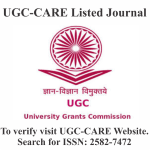ART SPEAKS LOUDER THAN WORDS: INDIAN FOLK ART FOR ANTHROPOCENE
DOI:
https://doi.org/10.29121/shodhkosh.v4.i1.2023.276Keywords:
Folk Art, Anthropocene, Critical PosthumanismAbstract [English]
This paper is an attempt to foreground how art and especially folk art has the potential to transform the way we view our relationship with the environment. It takes into consideration the Anthropocene, the epoch where the planet is bearing the load of disastrous human activities and looks at how Indian Folk Art might offer a solution. Folk Art, the paper argues has always adhered to a critical posthumanist ideology and aesthetic. The portrayal of nature in these artforms can offer us potent responses to Anthropocene. The first section of the paper talks about the connection between Folk Art and nature within a critical posthumanist framework. Folk art, not just through its themes but also through the elements it uses, is intricately intertwined with nature, and responds to the Anthropocene. Subsequent sections take into consideration different folk and tribal artforms and talk in depth about their connection with nature and prevalent themes. The paper also analyses some tribal and folk paintings and the folk artworks presented in India Art Fair in 2018. The scope of this paper is limited to four major folk artforms (Gond, Pattachitra, Madhubani, Warli) but the arguments made in this paper pertain to all folk arts in general.
Downloads
References
Alaimo, S. (2010). Bodily Natures : Science, Environment, and the Material Self. Indiana University Press. http://www.jstor.org/stable/j.ctt16gzmvh.
Bajpai, A. (2022). Contemporary Indian Art for the Anthropocene Era : Taking Charge of a Dying Planet. ShodhKosh : Journal of Visual and Performing Arts, 3(2), 1–14. https://doi.org/10.29121/shodhkosh.v3.i2.2022.124. DOI: https://doi.org/10.29121/shodhkosh.v3.i2.2022.124
Bhatia, N. (n.d.). Earth Warriors : Creating Oneness with the Environment Through Tribal Art. 90CAPS. Retrieved From 2022, November 29.
Braidotti. (2013). The Posthuman. Polity Press.
Dileep, G. (2020, August 11). Warli Tears. Warli Blood. Warli Art. Article 19. Retrieved From 2022, November 29.
ForbesIndia. (Chaitali Patel). Can Art and Craft Drive the Message of Climate Change Home ? Forbes India. Retrieved From 2022, November 29.
Heartney, E. (2020, June 19). Art for the Anthropocene Era. ARTnews.com. Retrieved From 2022, November 29.
Papavasİleİou, V., Nİkolaou, E., Andreadakİs, N., Xanthacou, Y., & Kaİla, M. (2020, December 31). The Role of Art in Environmental Education. IJAEDU- International E-Journal of Advances in Education, 287–295. https://doi.org/10.18768/ijaedu.819417. DOI: https://doi.org/10.18768/ijaedu.819417
Parashar, S. (n.d.). Gond Art : The Celebration of Nature. The Indegenous. Retrieved From 2022, November 29.
Patel, B. M. K., & Srivastava, S. (2020). Redefining the Folk Art - Warli Paintings in Interiors. Journal of Emerging Technologies and Innovative Research, 7(8), 424–426.
Preminger, S. (2012). Transformative Art : Art a Means for Long-Term Neurocognitive Change. Frontiers in Human Neuroscience, 6. https://doi.org/10.3389/fnhum.2012.00096. DOI: https://doi.org/10.3389/fnhum.2012.00096
Vakkalanka, H. (2013, November 3). Art, Love and life. Return to Frontpage. Retrieved From 2022, November 30.
Zukowski, A. (2018, May 15). The World Changes Through Art, but Can Art Change Opinions ? Medium. Retrieved From 2022, April 22.
Published
How to Cite
Issue
Section
License
Copyright (c) 2023 Siddharth Shankar Upadhyay

This work is licensed under a Creative Commons Attribution 4.0 International License.
With the licence CC-BY, authors retain the copyright, allowing anyone to download, reuse, re-print, modify, distribute, and/or copy their contribution. The work must be properly attributed to its author.
It is not necessary to ask for further permission from the author or journal board.
This journal provides immediate open access to its content on the principle that making research freely available to the public supports a greater global exchange of knowledge.

























